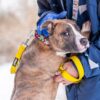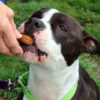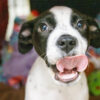Why Dogs Jump
Dogs jump up to say hello, quite simply. They don’t know how humans prefer to be greeted, and it never occurs to them that they might knock us over or ruin our clothes. Thankfully, consistent anti-jump training can quickly solve the problem for good. For this exercise, you’ll act as an on/off switch. When the dog is four feet on the floor, you’ll be “on” (verbal praise, petting, bending down to greet the dog, etc.). While the dog is jumping, you’ll be “off”(stand up, completely disengaged, no verbal attention, even in the form of “NO!”, turning your back when the dog jumps).
Teaching Dogs Not to Jump
The goal in part 1 is to teach your dog not to jump on you and other family members. There are two ways we can do this:
1. When your dog jumps on you, turn your back to him. go into your “off” position. Even giving a verbal correction like “NO!” is attention. It is much more effective if you completely disengage and turn your back to him. You may have to do this several times when you start. When he’s jumping, do not say anything to him. Just completely ignore him and keep turning until he puts all four feet on the floor.
- When he stops jumping, turn around to face him. If he jumps again, turn your back to him again, again, going into your “off” position. Repeat these actions until you turn around to face him and he doesn’t jump up. When he doesn’t jump, pet and praise him. If you have treats, give him one. If he gets too excited and jumps up again, turn your back again and start over.
- Do this exercise when you get home, when you have something in your hands that he wants, or any other time that he jumps on you.
- You must be absolutely consistent. You can completely wipe out being jumped on if you turn away every time. Don’t accidentally teach him that sometimes you can jump and sometimes you can’t, or he’ll always be looking for the times that it’s okay.
- ** If you turn your back and your dog just keeps jumping on your back, try walking away. It’s important that you completely ignore the dog—don’t talk to him or try to correct him. Withdrawing attention is more than enough motivation for them to try something else and ignoring helps to allow them to self-correct. This is an important part in teaching them to try a more appropriate behavior without being prompted. Pretend like he is not there. If walking away doesn’t work (he follows and jumps or tugs on your pants), you’ll have to give him a time out by either closing a door between you or quickly putting him behind a baby gate. Be careful not to act angry—just tell him “NO!” and do it. The point to get across is not “You’re a bad dog” but “When you act like that I won’t play with you.”
2. Tell him what you DO want! If he jumps up, turn your back and ask for a “sit” instead. Telling him what you do want will help to teach him a more appropriate behavior to offer instead of the jumping.
- Make sure to reward the behavior we do want far more than we ignore the behavior we don’t. We want the dog to learn what we expect of him. Rewarding what we want is key here!
Part 2 is to teach your dog not to jump on other people.
- Wherever possible, teach family and friends the Phase I exercise and have them practice it with your dog. When encountering people who you don’t know or people unwilling to do the
Phase I exercise you can do the following: - You can begin this training by having your dog sit for you when he wants you to say hi and pet him. Have family members and friends do the same.
- Then take it on the road. As a stranger is approaching your dog (or you are approaching a stranger with your dog after having ascertained that they wish to be approached), make sure you tell them “Please do not greet him unless he isn’t jumping!” Block your dog with your body if you need to buy time or focus your dog.
- If he starts to jump up while greeting, ask the person to stand up straight and turn their back. He must stay four on the floor as the person comes to pet him.
- Keep a close eye on your dog’s body. If the dog can’t stop jumping up, walk away and dog loses his opportunity to greet the person. This is not intended as a punishment, so don’t jerk the collar or use an angry voice. The intention is simply to keep her from jumping up (before she can scare someone or dirty their clothes) and to communicate that she lost her opportunity to
say hi. - As you do this, you can turn around to explain to the stranger that you’re teaching your dog not to jump. If they seem interested in the training or your dog, you can ask them if they wouldn’t mind you trying again. If so, repeat the above procedure until your dog doesn’t try to jump. At that point allow the person to pet your dog once he’s settled.
- If you find you are not making good progress—after practicing this on a dozen people your dog still gets the first try with each person wrong—you can get a little tougher by only giving your dog one chance with each person. If they blow the first chance they get walked away and don’t get to go back to try again.








